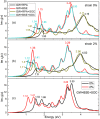Quasiparticle and optical properties of strained stanene and stanane
- PMID: 28634387
- PMCID: PMC5478662
- DOI: 10.1038/s41598-017-04210-w
Quasiparticle and optical properties of strained stanene and stanane
Abstract
Quasiparticle band structures and optical properties of two dimensional stanene and stanane (fully hydrogenated stanene) are studied by the GW and GW plus Bethe-Salpeter equation (GW-BSE) approaches, with inclusion of the spin-orbit coupling (SOC). The SOC effect is significant for the electronic and optical properties in both stanene and stanane, compared with their group IV-enes and IV-anes counterparts. Stanene is a semiconductor with a quasiparticle band gap of 0.10 eV. Stanane has a sizable band gap of 1.63 eV and strongly binding exciton with binding energy of 0.10 eV. Under strain, the quasiparticle band gap and optical spectrum of both stanene and stanane are tunable.
Conflict of interest statement
The authors declare that they have no competing interests.
Figures






References
-
- Neto AC, Guinea F, Peres NM, Novoselov KS, Geim AK. The electronic properties of graphene. Rev. Mod. Phys. 2009;81:109. doi: 10.1103/RevModPhys.81.109. - DOI
-
- Liu CC, Jiang H, Yao Y. Low-energy effective Hamiltonian involving spin-orbit coupling in silicene and two-dimensional germanium and tin. Phys. Rev. B. 2011;84:195430. doi: 10.1103/PhysRevB.84.195430. - DOI
-
- Qi XL, Zhang SC. The quantum spin Hall effect and topological insulators. Phys. Today. 2010;63:33–38. doi: 10.1063/1.3293411. - DOI
Publication types
LinkOut - more resources
Full Text Sources
Other Literature Sources
Miscellaneous

